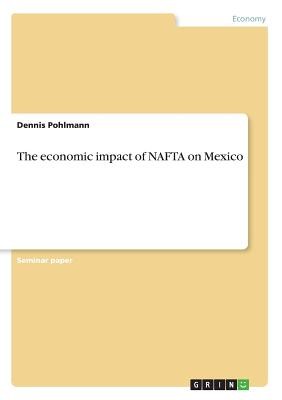
- We will send in 10–14 business days.
- Author: Dennis Pohlmann
- Publisher: GRIN Verlag
- Year: 2007
- Pages: 36
- ISBN-10: 3638672050
- ISBN-13: 9783638672054
- Format: 14.8 x 21 x 0.2 cm, softcover
- Language: English
- SAVE -10% with code: EXTRA
Reviews
Description
Seminar paper from the year 2006 in the subject Economics - International Economic Relations, grade: 1,0, Drury University (Breech School of Business Administration), course: International Economics, language: English, abstract: Many countries are reducing trade barriers and promoting regional economic integration. A result of this is the rising of free-trade areas in which the belonging countries trade freely among themselves without tariffs or trade restrictions. One example for a free-trade area is the North American Free Trade Agreement (NAFTA) founded by the U.S., Mexico and Canada. When NAFTA took effect on January 1, 1994, it created the world´s largest free-trade zone with a combined population of over 416 million and a total GDP of $12 trillion. Of course, the U.S., as the world´s largest single market, dominates the North American business environment. The goal of NAFTA is to eliminate all the trade barriers between the three countries over a 15-year period, completed in 2009. NAFTA also substantially reduces, but does not completely eliminate, nontariff trade barriers like import quotas, sanitary regulations, and licensing agreements. From the beginning, NAFTA had a lot of opponents in the U.S. as well as in Mexico. For example, U.S. labor unions feared a loss in jobs because of dislocating production from the USA to Mexico by reason of lower wages. In Mexico, farmers opposed and still opposing NAFTA because of the high U.S. subsidies on agricultural products that are imported to Mexico. There were also beliefs from environmental, social justice, and other advocacy organizations stating that NAFTA has unfavorable impacts on non-economic areas like public health or environment. On the other hand, Mexican proponents supporting NAFTA argued that open trade could reduce migration from Mexico into the U.S. in the long run since NAFTA brings an improvement of the Mexican economy relative to the U.S. economy (Acevedo & Espenshade, 1992, p. 742). Between 19
EXTRA 10 % discount with code: EXTRA
The promotion ends in 17d.13:56:41
The discount code is valid when purchasing from 10 €. Discounts do not stack.
- Author: Dennis Pohlmann
- Publisher: GRIN Verlag
- Year: 2007
- Pages: 36
- ISBN-10: 3638672050
- ISBN-13: 9783638672054
- Format: 14.8 x 21 x 0.2 cm, softcover
- Language: English English
Seminar paper from the year 2006 in the subject Economics - International Economic Relations, grade: 1,0, Drury University (Breech School of Business Administration), course: International Economics, language: English, abstract: Many countries are reducing trade barriers and promoting regional economic integration. A result of this is the rising of free-trade areas in which the belonging countries trade freely among themselves without tariffs or trade restrictions. One example for a free-trade area is the North American Free Trade Agreement (NAFTA) founded by the U.S., Mexico and Canada. When NAFTA took effect on January 1, 1994, it created the world´s largest free-trade zone with a combined population of over 416 million and a total GDP of $12 trillion. Of course, the U.S., as the world´s largest single market, dominates the North American business environment. The goal of NAFTA is to eliminate all the trade barriers between the three countries over a 15-year period, completed in 2009. NAFTA also substantially reduces, but does not completely eliminate, nontariff trade barriers like import quotas, sanitary regulations, and licensing agreements. From the beginning, NAFTA had a lot of opponents in the U.S. as well as in Mexico. For example, U.S. labor unions feared a loss in jobs because of dislocating production from the USA to Mexico by reason of lower wages. In Mexico, farmers opposed and still opposing NAFTA because of the high U.S. subsidies on agricultural products that are imported to Mexico. There were also beliefs from environmental, social justice, and other advocacy organizations stating that NAFTA has unfavorable impacts on non-economic areas like public health or environment. On the other hand, Mexican proponents supporting NAFTA argued that open trade could reduce migration from Mexico into the U.S. in the long run since NAFTA brings an improvement of the Mexican economy relative to the U.S. economy (Acevedo & Espenshade, 1992, p. 742). Between 19


Reviews